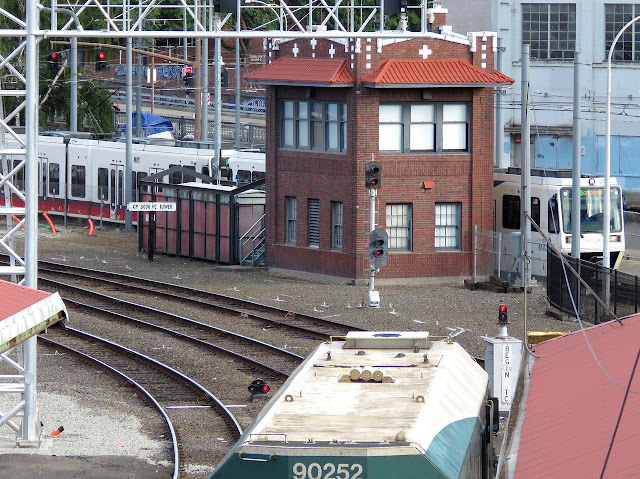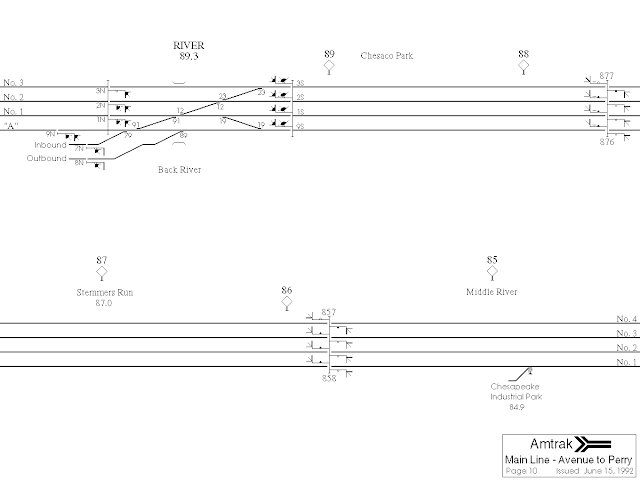Interlockings are limited to major junctions, yards and a few select crossovers. These are supplemented by hand operated temporary block stations. As I said before, both ABS and Interlocking signals are largely the same except for the possibility for route indications on the interlocking signals. This can range from the use of a single lamp in the "call-on" position, or separate heads, each governing a specific route. The wayside signals are supplemented by switch position indicators of the US&S ES-20 variety.
A blog devoted to explaining the ins and outs of North American railroad signaling, past, present and future. This blog seeks to preserve through photo documentation the great diversity and technical ingenuity of 20th century signaling and interlocking hardware and technology. Related topics cover interlocking towers and railroad communications infrastructure.
Note, due to a web hosting failure some of the photos and links may be unavailable.
Saturday, August 31, 2024
Portland MAX Signaling Primer
Interlockings are limited to major junctions, yards and a few select crossovers. These are supplemented by hand operated temporary block stations. As I said before, both ABS and Interlocking signals are largely the same except for the possibility for route indications on the interlocking signals. This can range from the use of a single lamp in the "call-on" position, or separate heads, each governing a specific route. The wayside signals are supplemented by switch position indicators of the US&S ES-20 variety.
Saturday, August 24, 2024
When Urbex Meets Signaling
While there is a lot of crossover between the urban exploration (Urbex) community and the rail enthusiast community, the Ven diagram doesn't quite work the way you think it does as there is both the type of enthusiasm the individual is involves with (rail, urbex or both) and the type of things they explore. When railfans explore rail stuff, they tend to put the resulting content in the rail bin, even if they are also into Urbex. Qualified railfans know the jargon and historical details to properly label their content, rendering it searchable and discoverable. On the other hand, Urbex people who aren't railfans, can get into a lot of interesting rail places, yet have little idea of what they are looking at, therefore harming discovery.
Not so long ago I found some critical WINSLOW tower interior photos from 2003 on an urbex blog site that just hadn't happened to appear on casual google searches until recently. In the same vein, I also found a great exploration of the former PRR MG tower on the famous East Slope between the Horseshoe Curve and the summit at Gallitzin. I routinely search for new "interlocking tower" videos, but not "switch tower" because the genericness of the term returns a lot of bad results. It was only after several years would YouTube searches include this video in my interlocking tower search due to the key words in the comments.
Despite their lack of historical context, the Urbex community can assist the railfan community by being willing to generally take more risks than railfans. In this example MG tower is known to see increased police patrols to the point where the risk of visiting is well known. On the other hand, Urbex folk don't care about getting train photos and can put more effort into not being see in addition to just having more experience in not being seen. Therefore, while railfans steered clear of MG, this guy was able to made a comprehensive video documentation. Another popular urbex assist has been the Hoosac Tunnel in northwestern Massachusetts, which sees both explorers and ghost-hunters occasionally getting some footage of the searchlight signals inside.
Anyway, the next time you are looking for some open source intelligence on some hard to access signaling artifact, try to use some urbex search terms. You might find something surprising.
Friday, August 16, 2024
New Signals at Portland Union Station
Saturday, August 10, 2024
The End of Main Line Pneumatic Points
There's a lot of work taking place on the former PRR Northeast Corridor these days and unfortunately it appears that the era of main line pneumatic point machines might be nearing an end. The stock of pneumatic interlockings had been dwindling for years with LANDOVER near Washington, DC, GRUNDY in Bristol, PA and FAIR in Trenton being the two latest to see wholesale conversion to electric US&S M3 style machines. Prior to that both THORN and PAOLI interlockings on the Harrisburg Line saw their pneumatics go even while their interlocking towers remained open.
Currently, what had been some of the best preserved main line pneumatic interlocking plants, RIVER and POINT at the north end of Baltimore's Bayview yard, are in the midst of an electric conversion as their turnouts are being replaced as part of a general maintenance project.
Unfortunately, due to their location, these two locations are difficult to photograph except from the rear of passing Amfleet equipped trains.
This will leave what is in my estimation only a single intact pneumatic main line interlocking plant, HOLMES, at Homesburg Jct in Philadelphia. OVERBROOK interlocking, with its staffed tower, is still largely pneumatic, but had seen select turnouts replaced with M3's.
Of course a significant number of terminal plants will remain pneumatic for the foreseeable future and one could possibly count terminal adjacent interlockings like Metra's TOWER A-2 and SEPTA's 16TH ST as Main Line as well, however neither see the high speed movements currently present at RIVER, POINT and HOLMES. The challenge for documentation is capturing the movement and sounds of the switches as they throw. At HOLMES this is most easily covered when local freights enter and exit the Buttleton branch, but this could also be achieved when tracks are out of service east or west of the plant. Of course the easiest way to engage with pneumatic point machines is to see them on rapid transit systems such as The PATH, NYC Subway and the SEPTA Broad Street Line.























